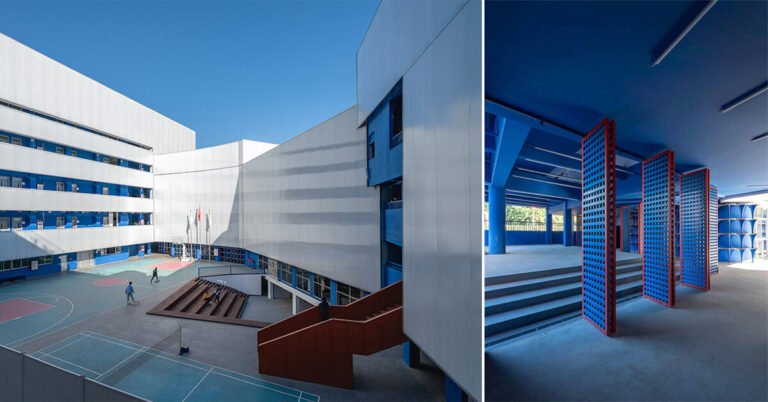Ahead of Earth Day, the AIA reveals LEED Platinum–targeting revamp of its D.C. headquarters
While the American Institute of Architects (AIA) has been proactive in laying out the framework for a sustainable, resilient, and equitable built environment capable of meeting the myriad challenges of the 21st century, the organization’s own national headquarters in Washington, D.C. remain a relic of yesteryear, seemingly preserved in amber circa 1970 within an aging concrete shell.
That, however, will soon change. Yesterday, the AIA unveiled schematic designs—a reveal made just ahead of Earth Day—of a major planned revitalization of its longtime home at 1735 New York Avenue NW. Completed in 1973, the landmark Brutalist structure has served the organization well over the decades but today is, simply put, woefully not up to snuff. The building has undergone limited renovations since the AIA first took up residence nearly 50 years ago, and most of its equipment is of a certain (unfortunate) vintage, from its single-pane windows to its uninsulated walls to its original gas-fired boilers. The internal layout of the building has also proven to be an organizational nightmare, preventing collaboration and “inhibiting the AIA’s current business practices.”
“Given the current state of our headquarters, we can’t afford not to make this critical investment in the future of our organization and the profession,” said AIA EVP and CEO Officer Lakisha Ann Woods in a statement.
Designed by The Architects Collective (TAC) after a previous competition-winning design by Mitchell/Giurgora failed to win approval from the U.S. Commission of Fine Arts, the building is directly adjacent to the AIA’s previous home within the National Historic Landmark–listed Octagon House, which housed the organization from 1898 up until the completion of the new building. The Octagon House is currently a museum operated by the AIA.
Following an extensive search in which 60 firms were initially considered, San Francisco-based EHDD has been selected to lead the exhaustive refresh and is joined by Hood Design Studio and Hartman-Cox Architects with Point Energy Innovations serving as a consultant. Turner Construction is serving as project contractor. EHDD partner Rebecca Sharkey explained that the “new design imagines a holistic new vision that will be welcoming, inspiring, and engaging; a bold new symbol of the AIA’s values.”
In addition to the core design team mentioned above, six architecture students from Historically Black Colleges and Universities (HBCUs) participated in an internship program held virtually last April through August in which they collaborated to help envision “a sustainable, post-COVID workplace of the future.”
The LEED Platinum–targeting revamp, one that will meet the energy use targets established by the AIA in its 2030 Commitment, is anticipated to save 58 percent in energy use (based on pre-pandemic usage) through the addition of a high-performance building envelope featuring window shading and electricity generation. The building’s single-pane windows will be replaced with double-pane bird-safe windows and the existing roof will be replaced. As for the antiquated pair of gas-fired boilers, both will be swapped out with seven air source electric heat pumps on the roof, which will also gain a 125 kW photovoltaic array. A high-efficiency lighting overhaul is also in the works.


Sharkey noted that the overhaul will be one of first “fully decarbonized major renovations” in the United States, and that “both embodied and operational carbon from the renovation will be fully addressed and will demonstrate a cost-effective path for achieving the AIA 2030 Commitment target of carbon.”
In addition to numerous upgrades and modernization efforts aiming to drastically slash the building’s energy consumption, the building’s interiors will be reconfigured to “create an equitable, inspiring, and innovative workplace and gathering place for AIA members, volunteers, staff and the community,” the organization explained. “Hierarchal spaces” will also be done away with in favor of “making executive areas more accessible and creating spaces where the Board of Directors can convene in a visible, transparent, and democratic way to advocate for the profession.” In addition to its LEED Platinum ambitions, the project will also seek WELL Platinum certification.

Among the numerous major elements is the conversion of the building’s glass-lined atrium into a lush interior garden, a reimagined ground-floor welcome center featuring touchdown spaces and galleries, and a new lower level that will feature a range of new amenities including a fitness center, mother’s room, library, VR/media lounges, coffee area, and archives. Up on the second floor, the design team has envisioned coworking spaces, a hosting suite, and the AIA’s advocacy center. Further up on the third and fourth floors, will be workspaces for AIA staff featuring “open and enclosed collaborative spaces as well as open-plan workstations and retreats for focused work alongside social spaces that are lacking in the current setup.”
Outside, the building courtyard will be reprogrammed for enhanced community engagement opportunities.


“AIA’s headquarters should serve as an expression of the value architects provide and align with the values we uphold as a profession,” said AIA 2022 President Dan Hart. “We have a responsibility to redesign this iconic building to the highest standards in sustainability, resilience, and equity. By demonstrating the powerful role design can play in improving our communities, we can show how to take the action that is needed to move the needle on climate action and to make the built environment healthier and safer for future generations. In order to effectively advocate for these changes, we must start by taking action ourselves.”
The AIA noted in an FAQ section that the renovation, estimated to cost between $50 and $70 million, will not impact members’ dues.


